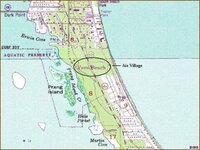New Question about 1715 Wreck + Barra d'Ays
Burgess and Clausen's book (Florida's Golden Galleon) continuously refers to "Barra d'Ays" (Bar of the Ais) as though that term meant "a thin section of barrier island."
All other uses of that term (by Mexia, by Romans, etc.) consistently refer to barrier island inlets, all of which have natural sandbars underneath them. I have never seen anyone use the term "Bar" to refer to thin sections of barrier island!
(Authors B&C themselves use the correct meaning of "Barra" when talking about the Bar of Matanzas--clearly NOT a thin section of barrier island!)
Given the blunders in B&C's book (pointed out in a Fla Hist. 1/4 review by E. Lyon), does anyone have any information pro or con regarding the meaning and usage of the term "Barra d'Ays?"
(Purpose: My co-author and I are preparing an article for publication in which we locate the archaeological remains of the paramount town of the Ais Indians, and the nearby Inlet of the Ais.)
thanks in advance,
Alan Brech
Palm Bay, FL
Burgess and Clausen's book (Florida's Golden Galleon) continuously refers to "Barra d'Ays" (Bar of the Ais) as though that term meant "a thin section of barrier island."
All other uses of that term (by Mexia, by Romans, etc.) consistently refer to barrier island inlets, all of which have natural sandbars underneath them. I have never seen anyone use the term "Bar" to refer to thin sections of barrier island!
(Authors B&C themselves use the correct meaning of "Barra" when talking about the Bar of Matanzas--clearly NOT a thin section of barrier island!)
Given the blunders in B&C's book (pointed out in a Fla Hist. 1/4 review by E. Lyon), does anyone have any information pro or con regarding the meaning and usage of the term "Barra d'Ays?"
(Purpose: My co-author and I are preparing an article for publication in which we locate the archaeological remains of the paramount town of the Ais Indians, and the nearby Inlet of the Ais.)
thanks in advance,
Alan Brech
Palm Bay, FL







